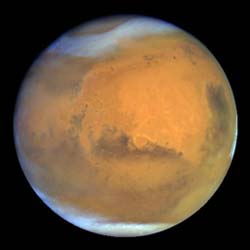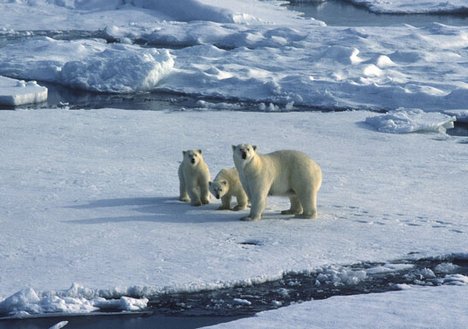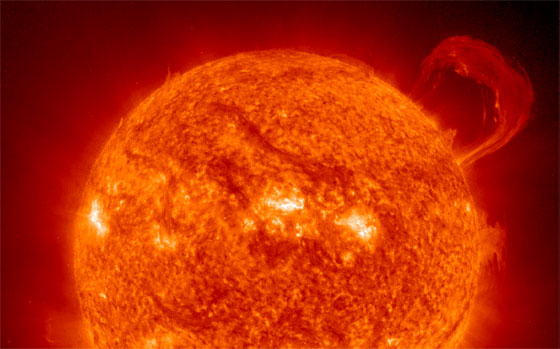 Most scientists agree the main cause of the current global warming trend is human expansion of the "greenhouse effect" -- warming that results when the atmosphere traps heat radiating from Earth toward space. Most scientists agree the main cause of the current global warming trend is human expansion of the "greenhouse effect" -- warming that results when the atmosphere traps heat radiating from Earth toward space.
Certain gases in the atmosphere behave like the glass on a greenhouse, allowing sunlight to enter, but blocking heat from escaping. Long-lived gases, remaining semi-permanently in the atmosphere, which do not respond physically or chemically to changes in temperature are described as "forcing" climate change whereas gases, such as water, which respond physically or chemically to changes in temperature are seen as "feedbacks."
Gases that contribute to the greenhouse effect include:
- Water vapor. The most abundant greenhouse gas, but importantly, it acts as a feedback to the climate. Water vapor increases as the Earth's atmosphere warms, but so does the possibility of clouds and precipitation, making these some of the most important feedback mechanisms to the greenhouse effect.
- Carbon dioxide (CO2). A minor but very important component of the atmosphere, carbon dioxide is released through natural processes such as respiration and volcano eruptions and through human activities such as deforestation, land use changes, and burning fossil fuels. Humans have increased atmospheric CO2 concentration by a third since the Industrial Revolution began. This is the most important long-lived "forcing" of climate change.
- Methane. A hydrocarbon gas produced both through natural sources and human activities, including the decomposition of wastes in landfills, agriculture, and especially rice cultivation, as well as ruminant digestion and manure management associated with domestic livestock. On a molecule-for-molecule basis, methane is a far more active greenhouse gas than carbon dioxide, but also one which is much less abundant in the atmosphere.
- Nitrous oxide. A powerful greenhouse gas produced by soil cultivation practices, especially the use of commercial and organic fertilizers, fossil fuel combustion, nitric acid production, and biomass burning.
- Chlorofluorocarbons (CFCs). Synthetic compounds of entirely of industrial origin used in a number of applications, but now largely regulated in production and release to the atmosphere by international agreement for their ability to contribute to destruction of the ozone layer. They are also greenhouse gases .
| |

Not enough greenhouse effect: The planet Mars has a very thin atmosphere, nearly all carbon dioxide. Because of the low atmospheric pressure, and with little to no methane or water vapor to reinforce the weak greenhouse effect, Mars has a largely frozen surface that shows no evidence of life.
|

Too much greenhouse effect: The atmosphere of Venus, like Mars, is nearly all carbon dioxide. But Venus has about 300 times as much carbon dioxide in its atmosphere as Earth and Mars do, producing a runaway greenhouse effect and a surface temperature hot enough to melt lead.
|
On Earth, human activities are changing the natural greenhouse. Over the last century the burning of fossil fuels like coal and oil has increased the concentration of atmospheric carbon dioxide (CO2). This happens because the coal or oil burning process combines carbon with oxygen in the air to make CO2. To a lesser extent, the clearing of land for agriculture, industry, and other human activities have increased concentrations of greenhouse gases.
The consequences of changing the natural atmospheric greenhouse are difficult to predict, but certain effects seem likely:
- On average, Earth will become warmer. Some regions may welcome warmer temperatures, but others may not.
- Warmer conditions will probably lead to more evaporation and precipitation overall, but individual regions will vary, some becoming wetter and others dryer.
- A stronger greenhouse effect will warm the oceans and partially melt glaciers and other ice, increasing sea level. Ocean water also will expand if it warms, contributing further to sea level rise.
- Meanwhile, some crops and other plants may respond favorably to increased atmospheric CO2, growing more vigorously and using water more efficiently. At the same time, higher temperatures and shifting climate patterns may change the areas where crops grow best and affect the makeup of natural plant communities.
The role of human activity
In its recently released Fourth Assessment Report, the Intergovernmental Panel on Climate Change, a group of 1,300 independent scientific experts from countries all over the world under the auspices of the United Nations, concluded there's a more than 90 percent probability that human activities over the past 250 years have warmed our planet.
The industrial activities that our modern civilization depends upon have raised atmospheric carbon dioxide levels from 280 parts per million to 379 parts per million in the last 150 years. The panel also concluded there's a better than 90 percent probability that human-produced greenhouse gases such as carbon dioxide, methane and nitrous oxide have caused much of the observed increase in Earth's temperatures over the past 50 years.
They said the rate of increase in global warming due to these gases is very likely to be unprecedented within the past 10,000 years or more. The panel's full Summary for Policymakers report is online at http://www.ipcc.ch/pdf/assessment-report/ar4/syr/ar4_syr_spm.pdf.
Read more...
 Bonn, 11 April 2010 - The first round of UN climate change talks since the UN Climate Change Conference in Copenhagen at the end of 2009 concluded Sunday in Bonn with agreement to intensify the negotiating schedule in order to achieve a strong outcome in Mexico at the end of the year. Bonn, 11 April 2010 - The first round of UN climate change talks since the UN Climate Change Conference in Copenhagen at the end of 2009 concluded Sunday in Bonn with agreement to intensify the negotiating schedule in order to achieve a strong outcome in Mexico at the end of the year.
In addition to the negotiating sessions already scheduled for 2010, governments decided at the Bonn April meeting to hold two additional sessions of at least one week each.
The additional sessions will take place between the 32nd session of the UNFCCC Convention subsidiary bodies from 31 May to 11 June 2010 and the UN Climate Change Conference in Mexico from 29 November to 10 December 2010.
The Ad Hoc Working Group on Long-term Cooperative Action under the Convention (AWG-LCA) invited its Chair to prepare, under her own responsibility, a text to facilitate negotiations among Parties, in time for the May/June sessions in Bonn.
"At this meeting in Bonn, I have generally seen a strong desire to make progress," said UNFCCC Executive Secretary Yvo de Boer. "However, whilst more meeting time is important, it is itself not a recipe for success," he cautioned.
 The UN's top climate change official called on governments to overcome differences, and work for greater clarity on what can be decided in the course of 2010 in the UN Climate Change negotiations. The UN's top climate change official called on governments to overcome differences, and work for greater clarity on what can be decided in the course of 2010 in the UN Climate Change negotiations.
"We need to decide what can be agreed at the end of this year in Cancún and what can be put off until later," he said.
According to Mr. de Boer, negotiators must tackle three categories of issues in the course of this year: issues which were close to completion in Copenhagen and can be finalized at the UN Climate Change Conference in Cancún at the end of the year; issues where there are still considerable differences, but on which the Copenhagen Accord can provide important political guidance; and issues where governments are still far from agreement.
"The UN Climate Change Conference in Cancún must do what Copenhagen did not achieve: It must finalize a functioning architecture for implementation that launches global climate action, across the board, especially in developing nations," said Yvo de Boer.
Read more...
Context
 Climate change is expected to hit developing countries the hardest. Its effects—higher temperatures, changes in precipitation patterns, rising sea levels, and more frequent weather-related disasters—pose risks for agriculture, food, and water supplies. At stake are recent gains in the fight against poverty, hunger and disease, and the lives and livelihoods of billions of people in developing countries. Climate change is expected to hit developing countries the hardest. Its effects—higher temperatures, changes in precipitation patterns, rising sea levels, and more frequent weather-related disasters—pose risks for agriculture, food, and water supplies. At stake are recent gains in the fight against poverty, hunger and disease, and the lives and livelihoods of billions of people in developing countries.
Tackling this immense challenge must involve both mitigation—to avoid the unmanageable—and adaptation—to manage the unavoidable—all while maintaining a focus on its social dimensions.
Strategy
Addressing climate change requires unprecedented global cooperation across borders. The World Bank Group is helping support developing countries and contributing to a global solution, while tailoring our approach to the differing needs of developing country partners. We are strengthening and building climate change partnerships with our member governments and a wide array of organizations.
In 2005, the Group of Eight asked the World Bank to develop a plan for more investments in clean energy in the developing world, in cooperation with other international financial institutions. The resulting Clean Energy Investment Framework identified the scale of investment needed for countries to access energy, especially in Africa; to help their transition to a lower carbon development path; and to adapt to climate variability and change.
At the request of our Development Committee in 2007, the Bank Group embarked on a comprehensive strategy to help address climate challenges and launched extensive global consultations. The consultations concluded in September 2008. The resulting strategic framework on development and climate change takes a demand-based approach to identifying and tapping new business opportunities for developing countries and helping them cope with new risks.
We aim to support development successes while offsetting costs that stem from climate change through climate-dedicated finance. Our strategy also highlights the need for action and interaction among all countries for the greater global good. In developing countries, we are working to:
- Support climate actions in country-led development processes;
- Mobilize additional concessional and innovative finance;
- Facilitate the development of market-based financing mechanisms;
- Leverage private sector resources;
- Support accelerated development and deployment of new technologies; and
- Step up policy research, knowledge, and capacity building.
Results
Climate vulnerability and risk management increasingly is part of our dialogue and work with developing countries. Key sectors affected by climate change include health, water supply and sanitation, energy, transport, industry, mining, construction, trade, tourism, agriculture, forestry, fisheries, environmental protection, and disaster management.
The World Bank Group has several projects underway to strengthen the knowledge base for climate change and to translate such insights into informed decision making. The 2010 edition of the World Development Report focuses on development in a changing climate. Climate change adaptation considerations are being integrated into Country Assistance Strategies. A new screening tool that gives us a simple way of assessing development projects for potential sensitivities to climate change and further work is being done on sector-specific tools and guidance, We are also piloting innovative climate risk insurance. The Global Facility for Disaster Risk Reduction and Recovery, which helps countries integrate disaster planning into their development strategies, is including long-term climate risk with the programs.
We are taking action on key issues:
- IFC, MIGA, and all World Bank regions have developed climate change strategies or/and business plans;
- Climate change issues are being integrated into new sector strategies under preparation;
- Over 60 percent of all new Country Assistance or Country Partnership Strategies in fiscal year 2009 substantively addressed climate-related issues;
- A growing range of activities and instruments to support climate resilient development and adaptation
- Continued growth in energy efficiency and renewable energy financing;
- Significant progress with new and innovative financing such as the Climate Investment Funds, the Forest Carbon Partnership Facility, climate risk management products, and “Green Bonds”;
- Rapid build-up in research & knowledge: The 2010 World Development Report on Development and Climate Change was launched on September 15, 2009. The global study on the Economics of Adaptation to Climate Change expected to be launched this fall. Several regional and sectoral flagship reports that address climate change issues were recently completed;
- Knowledge dissemination for key emerging technologies, such as Concentrated Solar Power and Smart Grids; and
- Low carbon country case studies designed to explore options for lower carbon development. They have been prepared for Mexico, are in final review stages for Brazil and India, and are underway for South Africa, Indonesia, and Poland.
We are committed to sharing our research as well as measuring results and applying lessons from our projects and partnerships. We are also helping young people become champions on key issues of climate change.
|
|




 Climate Change
Climate Change





 Bonn, 11 April 2010 - The first round of UN climate change talks since the UN Climate Change Conference in Copenhagen at the end of 2009 concluded Sunday in Bonn with agreement to intensify the negotiating schedule in order to achieve a strong outcome in Mexico at the end of the year.
Bonn, 11 April 2010 - The first round of UN climate change talks since the UN Climate Change Conference in Copenhagen at the end of 2009 concluded Sunday in Bonn with agreement to intensify the negotiating schedule in order to achieve a strong outcome in Mexico at the end of the year.  The UN's top climate change official called on governments to overcome differences, and work for greater clarity on what can be decided in the course of 2010 in the UN Climate Change negotiations.
The UN's top climate change official called on governments to overcome differences, and work for greater clarity on what can be decided in the course of 2010 in the UN Climate Change negotiations. Climate change is expected to hit developing countries the hardest. Its effects—higher temperatures, changes in precipitation patterns, rising sea levels, and more frequent weather-related disasters—pose risks for agriculture, food, and water supplies. At stake are recent gains in the fight against poverty, hunger and disease, and the lives and livelihoods of billions of people in developing countries.
Climate change is expected to hit developing countries the hardest. Its effects—higher temperatures, changes in precipitation patterns, rising sea levels, and more frequent weather-related disasters—pose risks for agriculture, food, and water supplies. At stake are recent gains in the fight against poverty, hunger and disease, and the lives and livelihoods of billions of people in developing countries.

